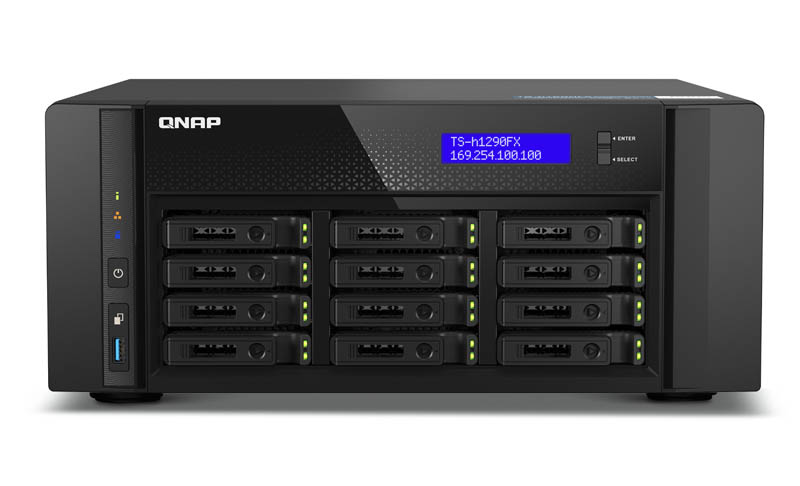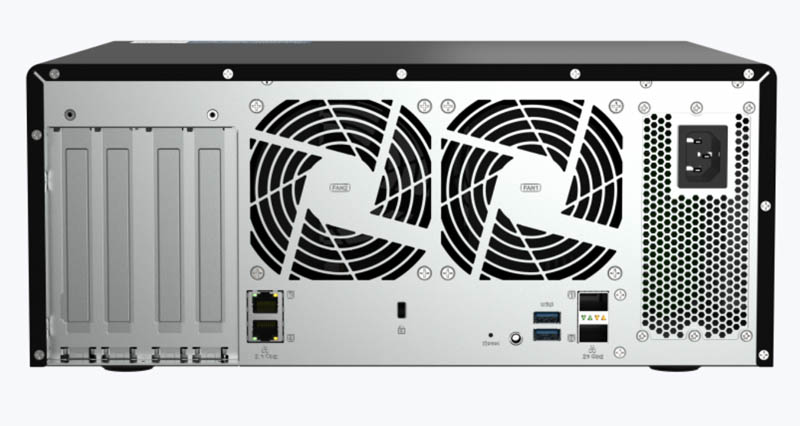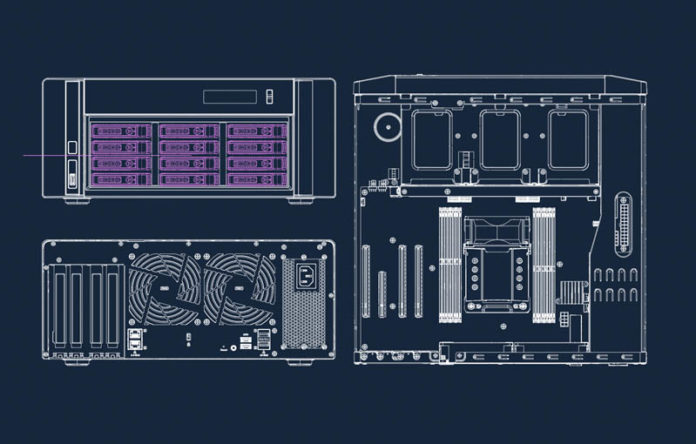The QNAP TS-h1290FX is a new AMD EPYC-powered NAS. While EPYC has been used in NASes before, QNAP is doing something different. It is powering a high-performance desktop tower NAS with EPYC giving it massive amounts of connectivity. The new NAS is finally out after its CES 2022 announcement.
QNAP TS-h1290FX AMD EPYC 25GbE SSD NAS
The QNAP TS-h1290FX uses twelve PCIe Gen4 NVMe SSD bays. One can utilize SATA as well, but if you are buying this unit, you likely will want to go NVMe. Being based on the AMD EPYC “Rome” generation means that the system can handle these 12x PCIe Gen4 lanes with a single CPU and have room for more expansion. One can also run QuTS Hero ZFS on this system.

The rear of the unit has a few cool features as well. The lower-speed networking is 2.5GbE, not 1GbE. QNAP also has two 25GbE SFP28 ports along with two USB 3 ports. The four PCIe slots are not just low-speed affairs. There are three PCIe Gen4 x16 slots and one x8 slot giving the unit the ability to add 100GbE or other networking and storage options. If you look at the cover image to this system above, the right side has the motherboard layout with the EPYC CPU and the PCIe slots.

The models are 8 and 16 core AMD EPYC 7002 series “Rome” CPUs. QNAP is using the “P” series parts for the lower cost. Also, the systems have 8x DDR4 DIMM slots so the systems can take up to 1TB of memory using 128GB DIMMs. The stock configurations are:
- TS-h1290FX-7302P-256G: AMD EPYC 7302P 16C/ 32T, 256GB DDR4 ECC RDIMM
- TS-h1290FX-7302P-128G: AMD EPYC 7302P 16C/ 32T, 128GB DDR4 ECC RDIMM
- TS-h1290FX-7232P-64G: AMD EPYC™ 7232P 8C/16T, 64 GB DDR4 ECC RDIMM
That is a fairly impressive set of specifications for the unit.
Final Words
This is clearly not going to be an inexpensive NAS answering one of the questions we are bound to get. With the EPYC platforms and all of the onboard devices, plus the additional cost for QNAP’s software and warranty, and so forth. At the same time, for those that want a high-speed NAS without the hassle of assembling one themselves, this appears to be a great option.
Realistically, using ZFS as a base with that solid underpinning, QNAP is reaching beyond just Synology but into higher levels of the SMB space, especially for video production. The gap between QNAP and Synology feels as though it is widening even more.
Perhaps this is one we should review.




…This is clearly not going to be an inexpensive NAS answering one of the questions we are bound to get…
$8,400 on bhphotovideo.com
You’re paying a huge premium for a desktop form factor – a similarly equipped Dell R6515 (Epyc 7232P/64gb/10 NVMe slot/dual x16 PCIe riser/25gbe LOM) is around $5k on their website, a lot less if you buy third-party memory.
But that desktop form factor is compelling if you need/want it. Seems single socket Epyc servers in tower/desktop form factors is super rare.
For homelab use I’d much rather have one of these QNAPs over a rack mount server, except for the cost. But for work use Dell R6515/7515/7525s seem more flexible and cost effective.
I wouldn’t turn one down, but I dream about a smaller/lower power version using PCIe4 Epyc embedded (which doesn’t yet exist) and E1.S (which is simple to adapt to M.2) ;-)
[quote]$8,400 on bhphotovideo.com[/quote]
:0
Mike N that Dell is still not as big. This has 2 more NVMe slots. More PCIe, more network built in. It also has the QNAP ZFS distro and a 5yr warranty.
It isn’t much cheaper to get the Dell.
Just curious, what drives would you put into this thing and how would you run them, raid 10, raid 5, JOBD, ZFS, ZFS@+1? Seems like getting some serious storage into this thing is going to cost crazy amounts and make the purchase price of $4900 to $8400 seems trivial almost. This NAS seems like a beast to me, but I am also happy with my TVS-h1288. Seems to do everything I need well, and then some.
-Lefty
An AMD EPYC CPU in a NAS box? Whodathunkit!
On the other hand…can it run CRYSIS in full HD insane framerate mode?
Sometimes I just gotta shake my head and ask…WHY?!?!
At the price tag why not buy a TrueNas box or build your own with an epyc (embedded) motherboard and a desktop NAS case instead?
The QNAP software isn’t really worth the premium when you need this much raw performance. And I say this as someone that’s a happy user of a small QNAP NAS
agreed, David, and as a Qnap customer that has had multiple issues with their software and lack of security and stability, I’d much rather build my own and run TrueNas, or even OMV over QNap’s software. I love their hardware, though!
I like QNAP hardware, especially the form factors for home/prosumer usage since cases like this are non-existent, but I’d prefer to install my own OS on them. The services are just as flaky as anything I could cook up, and the flexibility of a full OS isn’t there.
Olivier S: But a Dell 7515 in 2U can be configured for much cheaper, especially if you are willing to go aftermarket for RAM
Del 7515: 12 NVMe + 12 SAS/SATA 2.5″, AMD 7313P, 25Gb OCP module, 4 PCI-E x16 slots (2 FH, 2 HH), 5 years of Pro Support Plus 4-hour support for $5800. Add in $1500 for 256GB of RAM and you are at $7300. $1000 less than the comparable QNAP (with a slower processor)
I know where I would put my money.
QNAP makes some good hardware, but I don’t see a large market for this.
Nice article.
Curious who has the budget/use case for this?
This is for those video content businesses. Like if you’re running a small agency, Tiktok or Youtber business, or wedding videographer. Compared to the cameras places like STH uses from its videos, this isn’t that bad pricing. Those are the same people who don’t want to buy a system then install software. QNAP’s wizards are really easy even for low-tech skilled people. That’s what their doing with this. It’s a box to plug into their switches and have fast connections for direct video editing.
The only gap widening between qnap and Synology is qnap’s bugs and security flaws.
Too bad this isn’t actually available anywhere.
For those thinking about this unit for high end post production video I suggest you look up how much of London’s Hollywood post production is on Azure. Totally remote desktop because of need for six monthly (pre supply chain disruption) upgrade cadences having huge wages impact
London has done a vast amount of Hollywood business in recent years because the government has been underwriting whole performance bonds guaranteeing the movie delivery.
Potentially this might even explain the availability zone freeze due to revival of the theater audience.
I would much rather have some case manufacturers make a chassis that would have the bays for the diy crowd. 12 bays in a “desktop” form factor to compete with the QNAP/Synology offerings would be a great addition and a confirmed sell for me.
How long would it take for raw camera outputs to be uploaded to a cloud storage service? Seems like that would take some time (based on your connection) and also cost you a lot with the zillions of revisions video files go through prior to being finalized.
I would assume the Azure solution is only good for folks with extremely deep pockets who can spend enough to get special deals on services (including S3/blob).
While I don’t endorse the trend of direct attaching networking to a NAS and just investing in switches… You could load this thing up with 4x dual 100gbe and breakout to 32x 25gb links.
Probably cheaper to just buy a sound isolating rack though at that price. Or do what I did and drill two 120mm holes in the top of your TOR switch and pump quiet, high pressure fans in through the top.
Wow … QNAP stepping more into the big boy Sorta Mid Server world. EPYC, NVME or SSD 16 mounts, multiple X16 PCIe slots, dual 25Gb, 2.5Gb too and more. But only 1 PS, no HDMI … Hmmh. Clearly tons of serious hardware & capability built in. So Patrick I hope u guys at STH can get your hands on one soon and produce a full blown video assessment. As always Thanks to STH for helping us understand what’s out there in the NAS, Mini PC, Memory, Network switch, etc. worlds. Keep it up!